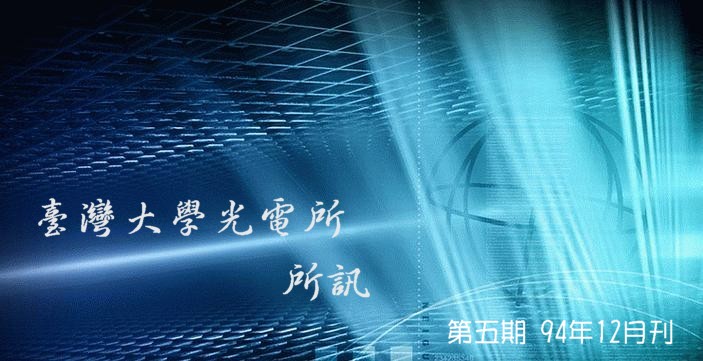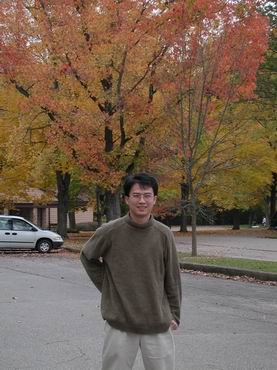
发行人:杨志忠所长 编辑委员:蔡睿哲 主编:林筱文 发行日期:2005.12.01
![]() 为促进本所研究教学发展,提升国际学术地位,加强与产业界之合作关系,本所特于94年12月23日及12月24日举办「前瞻性光电科技学术教育交流讲座」、「94学年度光电所咨询委员会会议」二项活动,请本所师生共襄盛举。该二项活动时程如下
:
为促进本所研究教学发展,提升国际学术地位,加强与产业界之合作关系,本所特于94年12月23日及12月24日举办「前瞻性光电科技学术教育交流讲座」、「94学年度光电所咨询委员会会议」二项活动,请本所师生共襄盛举。该二项活动时程如下
:
![]() 12月23日「前瞻性光电科技学术教育交流讲座」
12月23日「前瞻性光电科技学术教育交流讲座」
|
活动名称 |
前瞻性光电科技学术教育交流讲座 |
|
|
日期 |
94年12月23日 |
|
|
地点 |
博理馆101演讲厅 |
|
|
8:40~9:00 |
开 幕 |
|
|
演 讲 时 程 表 |
||
|
9:00~10:20 |
刘容生 所长 Dr. Yung S. Liu |
工业技术研究院光电所
|
|
讲题:Semiconductor Lighting - Technologies and future challenges |
||
|
10:40~12:00 |
吴明强 教授 Professor Ming C. Wu |
University of California, Berkeley Department of Electrical Engineering and Computer Sciences & Berkeley Sensor and Actuator Center |
|
讲题:New Trends in Optical MEMS |
||
|
12:20~14:00 |
午餐(台大第一活动中心贵宾室) |
|
|
14:00~15:20 |
陈永睿 教授 Professor Yung Jui Chen |
Department of Computer Science and Electrical Engineering University of Maryland, Baltimore County |
|
讲题:Future Directions of Planar Lightwave Circuits |
||
|
15:35~16:55 |
吴诗聪 教授 Professor Shin-Tson Wu |
College of Optics and Photonics University of Central Florida |
|
讲题:Tunable Photonic Liquid Crystal Devices |
||
|
17:10~18:30 |
郑克勇 教授 Professor Keh-Yung Cheng |
Department of Electrical and Computer Engineering University of Illinois at Urbana-Champaign |
|
讲题:Hyper-Uniform Nanophotonic Technologies for Ultra-Fast Optoelectronic |
||
![]() 12月24日「94学年度光电所咨询委员会会议」
12月24日「94学年度光电所咨询委员会会议」
※ 咨询委员介绍 ※
1. 刘容生所长 工业技术研究院光电所
Dr. Yung S. Liu is Fellow and VP of Industrial Technology Research Institute (ITRI) in Hsinchu, Taiwan, and serves as General Director of the Opto-Electronics and Systems Labs (OES). He directs R&D programs developing the advanced technologies in the areas of optical data storage, imaging and display, and opto-electronics devices and components to support a rapidly growing opto-electronic industry in Taiwan. He received his Ph.D. degree in Applied and Engineering Physics from Cornell University and BS in Physics from National Taiwan University.
Prior to joining ITRI in 1998, he was with GE Corporate R& D Center in Schenectady, New York where he held various responsibilities managing programs in optical data communication, advanced interconnect, solid state lasers and nonlinear optical devices. He received numerous awards for his technical and management achievements including GE Managerial Award for his leadership role in high power laser technology and business development; GE Outstanding Achievement Award for his technical contribution to solid state slab lasers; GE Patent Awards and Publication Awards. In 1998, Dr. Liu was selected by Industry Week’s as one of the “50 R&D Stars to Watch” for his leadership role in a DARPA program that pioneered the technology development of high speed parallel optical interconnect using 32-channel VCSEL array in advanced digital systems. In 2003, Dr. Liu won the prestigious 10th Tung Yuen Award (东元科技奖) for his significant contribution to the advancement of optoelectronic technology in Taiwan.
Dr. Liu is Fellow of the Optical Society of America (OSA), Fellow of PSC, Senior Member of IEEE, and a member of American Physical Society, and SPIE. He has served various professional committee functions in IEEE, APS, OSA, SPIE and consulted for UN Development Program, Max-Planck Society, National Science Council of Taiwan, and ITRI. He has authored over 70 publications and holds 28 US patents. Currently, he is President of the Optical Engineering Society (Taiwan), and President of the Taiwan Optical Communication Industry Alliance (TOCIA), founded in 2001 and founder of the Solid State Lighting Industry Association (SLIA) in 2002. Dr. Liu also serves as a board member of Taiwan Electronic and Electrical Manufacturers Association (TEEMA), Chinese Physical Society and President-Elect of the Photonics Society of Chinese- American (PSC), the largest professional society of Chinese-American in photonics in USA (2005/7)
2. 吴明强教授 University of California, Berkeley
Dr. Ming Wu is Professor of Electrical Engineering and Computer Sciences at the University of California, Berkeley, and Co-Director of Berkeley Sensors and Actuators Center (BSAC). His research interests include optical MEMS (micro-electro-mechanical systems), optoelectronics, and biophotonics. He received his B.S. degree from National Taiwan University, and M.S. and Ph.D. degrees from UC Berkeley in 1983, 1985, and 1988, respectively, all in Electrical Engineering. Before joining the faculty of UC Berkeley, Dr. Wu was a Member of Technical Staff at AT&T Bell Laboratories, Murray Hill, from 1988 to 1992, and Professor of Electrical Engineering at UCLA from 1993 to 2004. He also held the position of Director of Nanoelectronics Research Facility and Vice Chair for Industrial Relations during his tenure at UCLA. In 1997, Dr. Wu co-founded OMM in San Diego, CA, to commercialize MEMS optical switches.
Dr. Wu has published over 400 papers, contributed 5 book chapters, and holds 11 U.S. patents. He is a David and Lucile Packard Foundation Fellow (1992-1997), and an IEEE Fellow. Dr. Wu was the founding Co-Chair of IEEE LEOS Summer Topical Meeting on Optical MEMS (1996), the predecessor of IEEE/LEOS International Conference on Optical MEMS. He has also served in the program committees of many technical conferences, including MEMS, OFC, CLEO, LEOS, MWP, IEDM, DRC, ISSCC; and as Guest Editor of two special issues of IEEE journals on Optical MEMS.
3. 陈永睿教授 University of Maryland, Baltimore County
Professor Yung Jui (Ray) Chen received his BS in Physics from National Tsing Hua University in 1969 and Ph.D. in Physics at the University of Pennsylvania (1976). After a brief postdoctoral period at Penn, he joined the Advanced Microelectronic Laboratory at McDonnell Douglas Astronautics Co. in 1977. From 1980 to 1987, Dr. Chen conducted fiber optical communications related research at GTE Laboratories. During the ten years in industry, he worked on MOS/MNOS VLSI technology, wafer scale integration, Ultra- fast optical spectroscopy, linear and nonlinear optics of semiconductors and organic polymers, integrated optics and optoelectronic devices. In 1987, he moved to academe and became one of the founding faculty members of the Department of Electrical Engineering at University of Maryland, Baltimore County.
Dr. Chen is currently the UMBC Presidential Research Professor, a full professor of Computer Science and Electrical Engineering and the Director of Photonics Technology Laboratory. His group's current research interest covers photonic integrated device design, processing, testing, material sciences and physics, WDM broadband optical communications and networking. Dr. Chen is a fellow of Optical Society of America and Photonics Society of Chinese Americans, senior member of IEEE and member of American Physical Society.
4. 吴诗聪教授 University of Central Florida
Shin-Tson Wu is a PREP professor at the College of Optics and Photonics, University of Central Florida. Prior to joining UCF in 2001, Dr. Wu worked at Hughes Research Laboratories (Malibu, California) for 18 years. He received his Ph.D. from the University of Southern California and his BS in physics from National Taiwan University.
Dr. Wu is a Fellow of the IEEE, SID, and OSA. He is a recipient of the SID Special Recognition Award, IEEE Outstanding Engineer Award, ERSO (Taiwan) Special Achievement Award, Hughes team achievement award (for transferring liquid crystal technology to JVC), and Hughes Research Labs best paper award. Prof. Wu has co-authored 2 books: “Reflective Liquid Crystal Displays” (Wiley-SID, 2001; this book is rated as a 5-star text by Amazon.com), and “Optics and Nonlinear Optics of Liquid Crystals” (World Scientific, 1993), 5 book chapters, over 200 journal papers, and 25 issued patents. Prof. Wu is the founding Editor-In-Chief for the IEEE/OSA Journal of Display Technology, and an associate editor for the Journal of SID.
5. 郑克勇教授 University of Illinois at Urbana-Champaign
Professor Keh-Yung (Norman) Cheng received the B.S. degree in Electrical Engineering from Chung-Cheng Institute of Technology (CCIT), Taiwan, Republic of China in 1969 and the M.S. and Ph.D. degrees in Electrical Engineering from Stanford University, Stanford, California in 1972 and 1975, respectively.
From 1975 to 1979, he was a faculty member with the Department of Electrical Engineering, Chung-Cheng Institute of Technology in Taiwan. In 1979, he joined Bell Laboratories, Murray Hill, NJ, where he began research in MBE technology. His research in this area led to the development of rotating substrate holder for uniform MBE growth, the enhancement of electron mobility in modulation doped GaInAs/AlInAs/InP heterostructures, the first demonstration of dilute nitride III-V compound semiconductors, and the invention of quantum wire heterostructure lasers. Since 1987, he has been with the Department of Electrical and Computer Engineering, University of Illinois at Urbana-Champaign, where he is presently a Professor. From 2000 to 2004, he was the Director of the Bio-Optoelectronic Sensor Systems (BOSS) Center. The BOSS Center was a consortium of seven universities and sponsored by DARPA. In 2004, he became the Director of the Hyper-Uniform Nanophotonic Technologies (HUNT) for Ultra-Fast Optoelectronic Systems Center. The HUNT Center is a consortium of the University of Illinois, Columbia University, Georgia Tech and Harvard University, and sponsored by DARPA under the University Photonics Research Centers program. During the 2003 academic year, he was a Ministry of Education Distinguished Visiting Chair Professor at the Institute of Optoelectronic Technology, National Tsinghua University, Taiwan. His current research interests are in the areas of in situ fabrication of low-dimensional optoelectronic materials and devices, novel high-speed optoelectronic devices, and the development of mid-IR optoelectronic devices. He has published more than 200 technical papers on compound semiconductor materials and devices.
Dr. Cheng is a member of Sigma Xi, the American Physical Society, and the American Vacuum Society. He is a Fellow of IEEE and a Fellow of the American Association for the Advancement of Science (AAAS).
6. 卢博彦执行副总经理(兼任视讯显示器事业群总经理) 友达光电股份有限公司
卢博彦博士于2002年担任友达光电之执行副总,负责视讯显示器事业群(Audio-Video Display Business Group),以及友达科技中心(ATC)研发团队,掌管新产品、新制程、新技术之研发。卢博士于1974年毕业于台湾大学化工系,并分别于1976年及1982年取得美国伊利诺大学化工所之硕士及博士。他在1978~80于美国Gould实验室担任资深工程师、1982-95于美国贝尔(Bell Labs)实验室担任技术经理、1995-97于工研院电子所担任LCD产业联盟副组长,并于1997年加入达碁科技(友达光电之前身)。2003年卢博士获经济部颁发「平面显示器组件产品技术奖」及「杰出人士贡献奖」。
※ 咨询委员会议程 ※
|
活动名称 |
94学年度光电所咨询委员会会议 |
|
日 期 |
94年12月24日 |
|
地 点 |
博理馆201会议室 |
|
委 员 |
刘容生(召集人) 、郑克勇、陈永睿、吴诗聪、卢博彦、吴明强 |
|
时 间 |
活 动 内 容 |
|
09:00~10:00 |
主管致辞:校长、教务长、院长、所长 评鉴委员介绍暨系所务概况、发展简报 |
|
10:00~10:56 |
教 师 研 究 简 报 |
|
10:56~11:30 |
休 息 |
|
11:30~12:26 |
教 师 研 究 简 报 |
|
12:26~14:00 |
午 餐 及 休 息 |
|
14:00~14:56 |
教 师 研 究 简 报 |
|
14:56~15:30 |
休 息 |
|
15:30~16:30 |
委 员 与 教 师 座 谈 |
|
16:30~16:50 |
休 息 |
|
16:50~17:50 |
委员与学生代表座谈 |
|
17:50~18:30 |
委 员 讨 论 |
|
18:30~20:30 |
委 员 建 议 座 谈 会 |
|
晚 餐 |
|
|
黄建璋助理教授于1994年毕业于台大电机系,1996年毕业于台大光电所。在海军服役两年后,至美国伊利诺大学香槟分校 (University of Illinois, Urbana-Champaign) 攻读电机博士,并于2002年获得学位。黄教授之后在加州圣荷西 (San Jose, California) 的WJ (Watkins Johnson) communication担任Staff Scientist,负责高频无限通讯的组件设计与分析,并负责解决RF功率放大器 (power amplifier) 及mixer在生产阶段所可能遇到的问题。WJ相关产品的良率在他的主导下有显著的提升。他在2004年回到台湾,先在奇景光电工作短暂的时间,随后加入台大电机系及光电所担任助理教授。 研究之余,黄教授借着广泛的兴趣来放松自己的身心。他喜欢爬山、游泳、打网球,在美国时还打过高尔夫球;不过黄教授很幽默地表示最近比较少游泳了,因为头发有愈来愈少的趋势。除了运动之外,黄教授也喜欢看电影,他还有个很特别的嗜好,就是陪老婆逛街;看来在学校努力工作的黄教授,私底下也有着很甜蜜惬意的休闲生活呢! |
|
黄建璋教授为Phi-Tau Phi荣誉会员,他在1996年曾获得台湾光电学会最佳学生论文奖。目前黄教授研究的重点在白光LED的制程及量测,希望在氮化物的基础上研发其它Ⅱ-Ⅴ族或Ⅳ化物的红绿光LED以制成白光,而使其能应用到TFT-LCD背光模块甚至一般照明。另外,研究室另一重点为有机或氧化金属材料的透明低温晶体管研究,以用在透明可绕式显示器上。 对于光电产业的未来,黄教授认为科技是跟着人类的需求走的,近来人们开始需要平面显示的接口,不久的将来人类对半导体光源的需求会与日俱增,再来能源的替代会在一二十年间创造新的产业;因此,现在投入光电产业的研究,正是踏在现在及未来明星产业的浪头。
v
黄教授对于同学们在学习方面有下列的建议:
黄教授鼓励同学们上了研究所后,要「在实作中学习」。 Don’t trust papers. Don’t trust textbooks. Do it and you’ll learn it.
|
|
奈米半导体光电实验室---林清富教授
林清富教授研究领域:
量子井/量子点发光组件、奈米结构之硅半导体发光组件、奈米结构之研制与光电特性
奈米是长度单位,当半导体或物质结构小到数十或数奈米时,会有量子现象产生,使其物理和光电特性与传统物理的认知不同。如量子井会有特定的能阶,使量子井雷射特性获得改进,因此量子井雷射已广泛应用在许多地方。我们也利用不同宽度量子井结构在同一组件中,每一量子井提供其发光波长和对应频宽,使得整体的发光频宽增加数倍,可使半导体光放大器几乎涵盖整体的光通讯波段,约可有1300nm到1600nm的范围。最近奈米更引起广泛的注意,因为奈米尺度下的各类影响,远超过以往的认知。我们发现运用奈米结构和奈米粒子,可以改变电子和电洞的复合行为,而提升硅半导体的发光效率,改变过去所认为的间接能隙特性。然而奈米尺度的影响有正面和负面,因此在制作奈米结构和运用奈米粒子当中,我们也要留意维持硅半导体的高品质,使电子和电洞的非幅射性复合机率,保持在相当低的状态。
我们对于奈米结构应用在光电组件有持续的兴趣,一方面我们探讨奈米结构对光电组件特性的影响,另一方面也研究制作、观察、应用奈米结构的新技术,希望能结合奈米技术与光电组件技术,使电子和光电可以整合于硅半导体芯片上,让光讯号传输或用光做讯号处理更方便。
光子晶体与奈米光电研讨会
(Workshop on Photonic Crystals and Nano-Photonics)
时间:94年11月4日(下午)及5日(全天)
地点:台湾大学电机信息学院博理馆101演讲厅
~ 花絮报导 ~
※ 会议经过 ※
光子晶体与奈米光电研讨会(Workshop on Photonic Crystals and Nano-Photonics)于94年11月4日(下午)及5日(全天),假台湾大学电机信息学院博理馆101演讲厅举行。由日本IEICE(电子情报通讯学会,The Institute of Electronics, Information and Communication Engineers)赞助,特别邀请到国际上极为著名之二位国外讲者:Kiyotoshi Yasumoto(Department of Computer Science and Communication Engineering, Kyushu University, Fukuoka, Japan)及Masaya Notomi(Photonic Nanostructure Research Group, NTT Basic Research Laboratories, Atsugi, Japan)发表专题演讲。另外,更邀集14位国内相关领域著名之学者专家发表卓越研究成果。
原本预期约150人与会,没想到各界反映热烈,座无虚席,至会后统计结果共高达291位国内外相关研究领域之专家学者学生与会,会中讨论热烈,收获丰硕。另外,再次感谢国科会工程处工程科技推展中心补助经费办理此研讨会,对于推动产学合作契机更上层楼,会议圆满成功。
※ 照片集锦 ※
 |
|
日本Kiyotoshi Yasumoto教授主讲 『Modeling of scattering, guidance, and radiation in two-dimensional photonic crystals』 后为主持人--台大光电所张宏钧教授,亦为IEICE台湾代表。
|
 |
|
日本Masaya Notomi教授主讲 『All-optical switching and dynamic nonlinear control in photonic crystals』
|
 |
|
场内座无虚席,反应热烈
|
贺!本所十一月份学生得奖记录
| 年度 | 姓名 | 奖项 | 指导教授 |
| 94 | 林圣杰 |
94学年度第一学期国际航电奖学金 |
邱奕鹏 |
| 94 | 庄凯翔 | 94学年度第一学期国际航电奖学金 | 李君浩 |
|
94 |
林皓武 |
94学年度财团法人联发科技教育基金会联发科技奖学金 |
吴忠帜 |
|
94 |
庄凯翔 |
荣获台湾应用材料公司补助 「新世代半导体种子成长营-硅谷之行」赴美参访计划 |
李君浩 |
|
94 |
陈冠宇 |
荣获台湾应用材料公司补助 「新世代半导体种子成长营-硅谷之行」赴美参访计划 |
李君浩 |
本所十一月份教师出国动态
|
姓名 |
开会日期 |
事由 |
会议名称 |
地点 |
|
杨志忠 |
94.11.7-11.10 |
开会 |
亚太地区光通讯研讨会 |
上海 |
|
李君浩 |
94.11.28-12.2 |
开会 |
材料研究学会2005年秋季会议 |
波士顿 |
|
杨志忠 |
94.11.28-12.2 |
开会 |
2005年美国材料学会秋季年会 |
波士顿 |
2005两岸光学微结构与激光技术研讨会,大陆与会代表游台湾
![]()
~ 小游故宫记 ~
光电所博士班学生巫汉敏
|
|
在11月份,十分幸运地,我参与了由台湾大学光电所及中央研究院原子与分子科学研究所所主办之『2005两岸光学微结构与激光技术研讨会』的部分筹备工作。在研讨会众多繁忙的准备事务中,更幸运地有了一天假期,陪同与会的大陆学者,一同游览了台北重要的历史景点,如国父纪念馆与中正纪念堂,其中也安排了一段故宫博物院的参观,其中略有所得,在此与各位分享小小的收获与心得。
当人长大后,重游故地,很容易地会有眼下景观等比例缩小的感觉。基隆港变小了、永安渔港的海堤变短、荡秋千变矮…等。正值国小、年纪幼小的我,眼中的故宫是非常宏伟的建筑,主馆前后分别是辽阔的广场与绵延而去的山野,但是到了现在,一样地不逃眼中那缩水的命运。甚至有些运气不佳,因为故宫的修建工程,封闭了大部分的主馆建筑,表示众多珍贵馆藏都将因空间缺乏而无法展示,是参观访客的损失。然而,感谢导览义工的详尽解说,让我在这短短的参馆几小时内,看到偌大精深中国文化的小小一隅,上至商周、下至清末、左视青铜钟鼎、右观玉石陶瓷,诗词书画万卷,却已让我感动于其中之美。
首先是青铜器,镇馆重宝之一---毛公鼎,是二千八百多年前商周时代的一件宗庙祭器。内壁铸有五百字的铭文,是现存铜器中,铭文最长的一件。记载着周宣王叔父毛公的治理大小政事,有功于国,毛公铸鼎传示子孙。在庄严与钟鼎的线条之中,我不禁有些脱线地心想---比起史册与书籍,钟鼎的铸造真是一个传示功勋的好方法呀!刻上铭文,除了有其独特的艺术美感外,也可以将自己生命的存在以一种不易被抹灭的方式长久地记录下来,存于天地之间,不怕风雨蚁虫之侵蚀,甚至也比现在典型的文件储存更有保存性。想想,古人如毛公之流真是用了一个相当有趣的方式来宣告呀。
玉石的展览中则是从看到玉石不同构型的显示,石器时代之带齿动物面纹展现朴质与尝试开发艺术的味道,而商周时代使用玉圭作为礼制用具,接续时代的前进,玉器就转化成精致的赏玩雕刻,玉佩、玉杯、带饰等,总是漂浮着细致与奢华的气息,相较之下,我还是喜欢大气而质朴的远古简单饰品。不过还是要提起故宫最著名的玉器---翠玉白菜与红烧肉,在精致的刻工下其实是母亲对女儿婚姻的祝福,知道艺术品背后的故事,那美感可以更容易地被感受到。
必定,我是天真加上没气质,当我看着看着汉唐宋的文物与雕刻,某一时刻的剎那,我直觉感到非常惊讶!文物上的字,我竟然看得懂耶!就是与现在一模一样的汉字,飘逸地驰扬于古纸之上,1000年前写的字,怎么!我会看得懂!理所当然的答案,我是中国人呀!心中有股感动,原来这就是文化的传承,一代接一代,却也已经流传千年,有形的钟鼎文物以及字,都可以以物质的型态留下,但我想,真正宝贵的是精神层面的价值观与思想,应该更值得我去仔细思索吧。
遇有可疑死禽,该如何通报?
![]()
台北市政府卫生局 回答:
目前台湾仍为非疫区,疫情等级为0级,且经长期监测结果也未发现高病原家禽流行性感冒(H5N1)案例,即表示目前在台湾生活环境中并无H5N1病毒存在,因此您无须过度惊慌。
而动物卫生检验所基于防疫之需要及降低民众的恐慌,也会不定期至辖区内公园采取野外鸟禽粪便进行监测,以期「早期监测、早期通报」,确保健康。若您有发现禽鸟大量死亡(10只以上),请与动物卫生检验所联系将派员前往采样检验。
如遇有可疑死禽的话,请不必恐慌,可马上通报环保局公害专线(02-2720-6301或02-2720-6302)来清理。于禽流感期间,环保局会协助民众处理户外可疑鸟禽粪便或尸体。如有发现大量不明原因异常死亡情形,也请绝对不要碰触。
若有可疑死禽需要检验,立即通报动物卫生检验所(02-8789-7158或02-8789-7116)即马上派员前往处理。
本文由【KingNet 国家网络医院】提供
